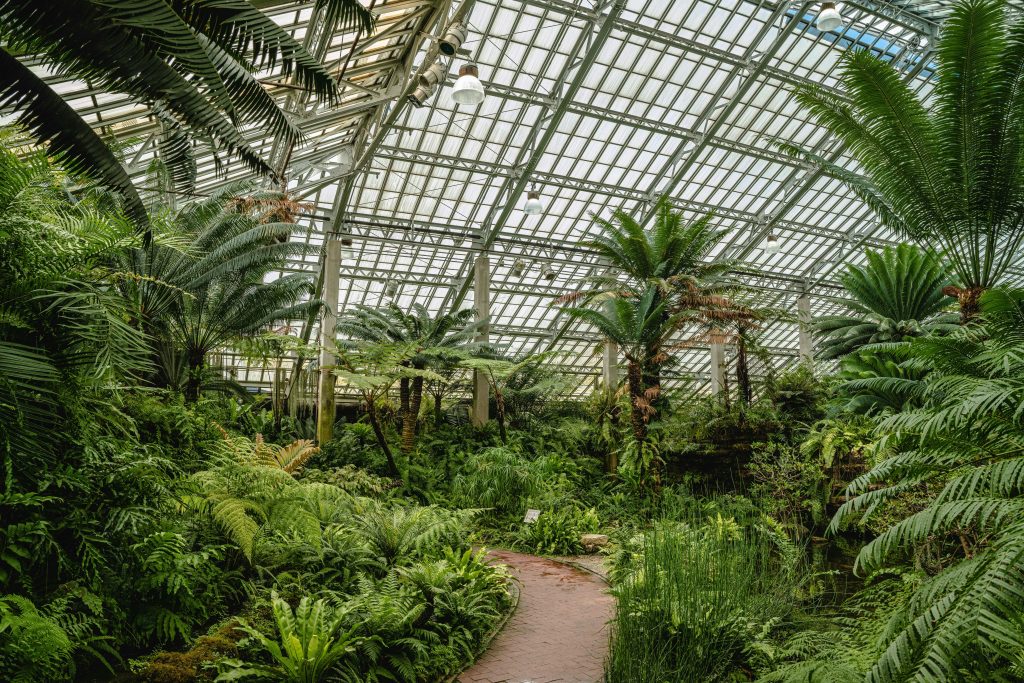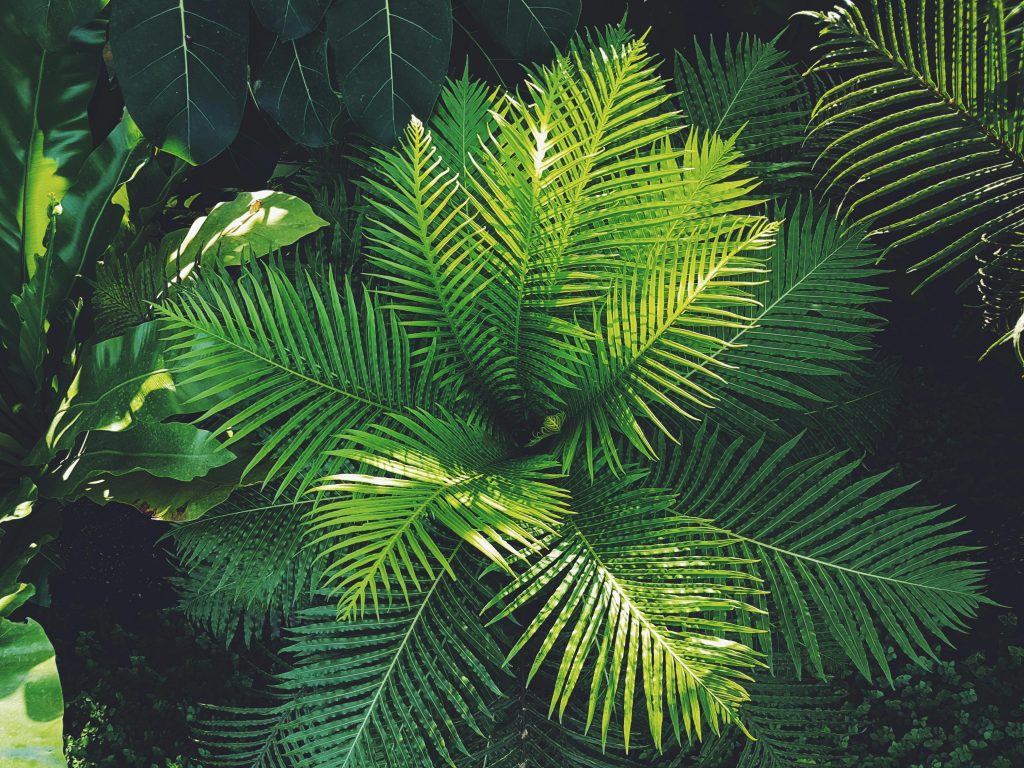
Among the country’s largest and best botanical conservatories, Garfield Park Conservatory is a green respite in the heart of a major city. It’s a short 15-minute drive west of downtown Chicago in the Garfield Park neighborhood, which is on the city’s West Side.
With 10 acres of outdoor garden installations as well as eight indoor display gardens spanning two acres, Garfield Park Conservatory has enough to keep flower lovers busy for 2-3 hours. Your visit might also include checking out a rotating exhibit. In recent years, these have included Dale Chihuly’s stunning glass art interspersed with the conservatory’s flora and fauna and an exhibit with interpretive panels about George Washington Carver’s contributions to agricultural science.
Suffice it to say, there’s a lot to see here. In this guide, I’ll share how to spend your day at the Garfield Park Conservatory and when is the best time to go. But first, let’s take a look at how this botanical wonder got here in the first place.
Garfield Park Conservatory history

Located in the 184-acre Garfield Park — designed by William LeBaron Jenney, who also designed the world’s first skyscraper in 1884 (Chicago’s Home Insurance Building) — Garfield Park Conservatory debuted in 1908.
It was created by people in the community to preserve and protect the park. Today it’s managed by the Chicago Park District and considered a top attraction in Chicago.
Three West Side parks — each with their own conservatories, although in need of repair — teamed together on a larger, more impressive location to display plant collections.
Famed landscape architect Jens Jensen worked with three Prairie School architects to create what was then the largest publicly owned conservatory in the world. As Chicago is already a city well-known for amazing architecture, this conservatory will appeal to any fan of historical design.
Fun fact: Both Garfield Park and the conservatory are listed on the National Register of Historic Places.
What to see at Garfield Park Conservatory

Outdoor Gardens
Divided into distinct gardens, the conservatory includes 10 acres of outdoor gardens and they’re open year-round.
They vary in sizes, but you’re bound to find one that speaks to you. Maybe it’s the children’s garden if you’re traveling with little ones or the water lilies if you favor romantic landscapes. Visit each one and find your favorite.
Here’s are a few of my favorites:
- Artist’s Garden
- City Garden
- Demonstration Garden (growing produce that’s donated to food pantries and the Garfield Park Farmers Market)
- Water Lily Garden
- Bluestone Terrace
- Sensory Garden
- Play and Grow Garden (designed for children up to 8 years old)
Desert House

As the name implies, this house is all about succulents and cacti commonly grown in desert environments. There’s a varying level of dimensions in this house, from tiny plants to tall cacti.
Palm House

As the largest house at Garfield Park Conservatory, the Palm House has a ceiling that soars 65 feet, which puts the palms here on full display. This is the most tropical-themed garden at the conservatory, representing a variety of palms from around the world.
Show House

Almost everything grown in the Show House was cultivated on site and the layout remains as it was in 1908, restored after a hailstorm in 2011. Both the Winter Holiday Show and Spring Flower Show are hosted here. Highlights in this space are wildly fragrant jasmine plants during summer and the fluffy powder puff plant.
Aroid House

Named for the aroid plants that grow here, the Aroid House includes lots of examples of these flowering houseplants.
Local tip: Be sure to admire the Persian Pool, decorated with 16 glass yellow lily pads crafted by renowned glass artist Dale Chihuly.
Fern Room

This house is all about the diversity of ferns, including examples of ancient varietals as old as 300 million years. Showcasing these ferns was a key desire of Jensen’s when he designed Garfield Park Conservatory.
There’s even an indoor lagoon, which adds to the calming effect of being in this space, and a waterfall, too.
Horticulture Hall
This is a great space to relax with a snack or sit down for a spell at a bistro-style table with matching chairs after walking through the gardens or houses. It’s okay to bring in your own snacks.
Elizabeth Morse Genius Children’s Garden
Although closed for renovations until sometime in 2025, once this indoor garden opens, children will have a dedicated place to play. This is a complete renovation of the former 16,000-square-foot indoor Children’s Garden. There is also the outdoor Play and Grow Garden, open year-round except for inclement weather.
Gift Shop
A visit to Garfield Park Conservatory, especially for avid gardeners, wouldn’t be complete without poking around the gift shop. Plant markers, seed kits, books about gardening, and more are sold here. You can also find apparel, swag, and other items featuring the conservatory’s name and logo.
Where to eat at (and around) Garfield Park Conservatory
While Garfield Park Conservatory does not have a café or restaurant, the good news is that there are several restaurants nearby to grab a meal. The closest of these, Inspiration Kitchens, is less than a quarter-mile away and sources many ingredients from its own gardens. It’s open for lunch on Fridays and brunch on Sundays, and employees are in a sponsored 12-week food-service training program.
Another great restaurant is Turkey Chop in nearby Humboldt Park, just a half-mile away, where menu items often incorporate turkey but there’s also plenty of vegetarian items and soul food selections.
Know before you go

Here are a few tips from a Chicago local to get you started for your visit to the Garfield Park Conservatory. It’s pretty easy to get to and fun to explore, so there’s no reason not to put this free attraction on your Chicago itinerary!
How do you get to Garfield Park Conservatory?
Not only is Garfield Park Conservatory free to enter, the visitor’s parking lot is also free to use. This is located just south of the conservatory’s entrance.
For those who wish to use public transportation, it’s an easy 30-minute ride on the Green Line from downtown Chicago, exiting at the Conservatory-Central Park Drive stop.
Local tip: Divvy, which is Chicago’s shared-bicycle system, has a station at the conservatory, and there are also corrals for those arriving on their own bicycle.
When is the best time to visit the conservatory?
There’s always something in bloom here, so there’s no bad time to go. However, I recommend the annual Spring Flower Show if you haven’t been. It’s hosted in the Show House between February and May every year and is a huge draw for gardeners and flower-lovers.
Is Garfield Park Conservatory really free to visit?

Yes, this conservatory costs nothing to enter, although advanced reservations are suggested. You can make those — in the form of a timed-entry reservation — on its website.
Bookings are available up to 30 days out. Walk-in reservations may be available on the day of your visit, but those who live on the West Side, including the Garfield Park neighborhood, or are members of the conservatory receive priority.
Does Garfield Park Conservatory offer tours?
There are no guided tours available, but for those visitors who wish to dive deeper, there are plenty of events and programs tied to the conservatory’s mission of encouraging others to honor and embrace nature.
Many are family-oriented and are free to attend, such as Budding Botanists stations staffed by Nature Educators on Saturdays and Sundays from 10:30 a.m. to 2:30 p.m., and Art After Dark on Wednesday evenings, with participants’ art creations tied to nature.
Lectures and drop-in demonstrations for adults are free while yoga classes hosted in the Horticulture Hall one Wednesday a month carry a fee, as do classes in topics like beekeeping and art.
Is the Garfield Park Conservatory ADA accessible?
Every pathway at Garfield Park Conservatory is wheelchair-accessible as they are made of concrete, pavers or hard-packed gravel. A limited number of wheelchairs are available for rental at no cost. For children in wheelchairs, they can definitely experience the Elizabeth Morse Genius Children’s Garden thanks to a wheelchair-accessible spiral ramp stretching all the way to the Conservatory’s glass roof.
Beyond the Garfield Park Conservatory in Chicago

Hopefully, this guide provides a sneak peek at what you can expect to see and smell on a visit to Garfield Park Conservatory. Even if you don’t sport a green thumb or have a lot of gardening experience, the depth of history here, not to mention being in such an architecturally amazing space, never fails to impress guests.
Looking for more to explore in the area? Check out our suggestions for guided tours in Chicago.

